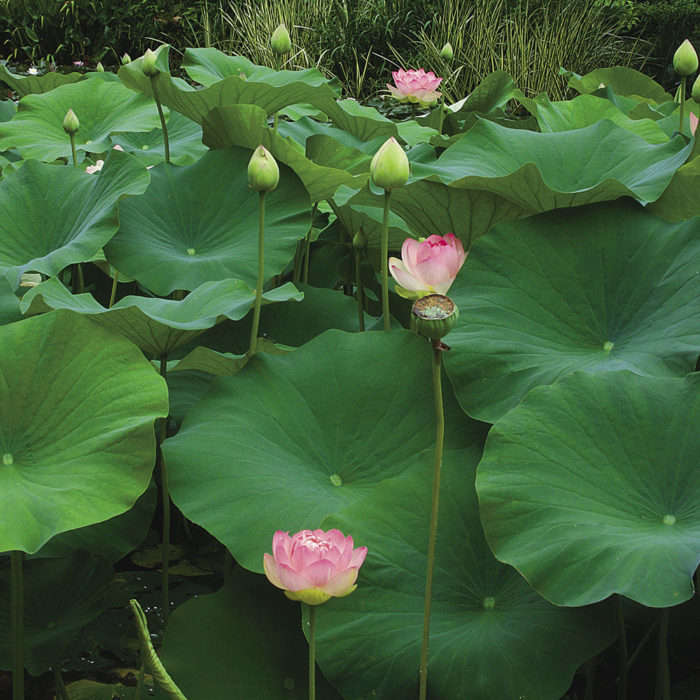
Whether you set out to design a garden with large-leaved perennials or you happen upon one or more in the nursery that you just cannot resist, adding an architectural giant to any landscape instantly transforms it from lackluster to lively. But selecting a large-leaved perennial can be daunting; after all, the plant will take up a lot of space and command significant attention. So it’s important to choose wisely. The following selections include my favorite large-leaved perennials.
1. An exotic flair that few plants can match
Name: Sacred lotus (Nelumbo nucifera and cvs.)
It might seem unusual to recommend an aquatic plant as a favorite large-leaved, sun-loving perennial. But if you sink sacred lotus into a pot and put the pot in the ground, then the plant can grow right alongside your other perennials to stunning effect. Its unique round leaves can reach more than 2 feet in diameter, and they have an exotic flair few plants can match. The striking blooms in shades ranging from soft yellow to pink, rose, and white—not to mention blends and bicolors—are borne just above the foliage, each lasting a few days before the petals fall to reveal the developing ornamental seedpod. Success with sacred lotus in the open garden depends on planting it in a nondraining container (lotus tub or other pot without holes) that will hold the water it needs to thrive.
USDA Hardiness Zones: 4 to 11
Size: Up to 5 feet tall and 4 feet wide
Conditions: Full sun; wet soil to standing water
2. It’s tall, tropical, and hardy
Name: Japanese fiber banana (Musa basjoo)
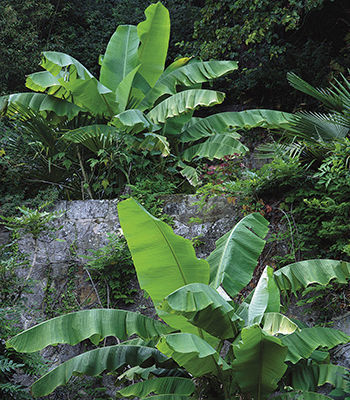
The tropical look has increased in popularity, perhaps, in part, to the introduction of the hardy Japanese fiber banana. Gardeners in regions as cold as Zone 6 (Zone 5, with protection) now have the ability to grow tropical bananas without having to replant them every year. Japanese fiber banana is not for the faint of heart or for gardeners with an extremely confined space because the plant gets big. Dying back to the ground each winter, it can easily reach 15 feet tall in a single season if well watered and fed. Bananas are hungry and thirsty plants; the richer the soil and the more you feed and water them while they are growing, the larger they get. Individual leaves might reach 6 feet long by 2 feet wide.
Zones: 6 to 10
Size: Up to 15 feet tall and wide
Conditions: Full sun; rich, moist, well-drained soil
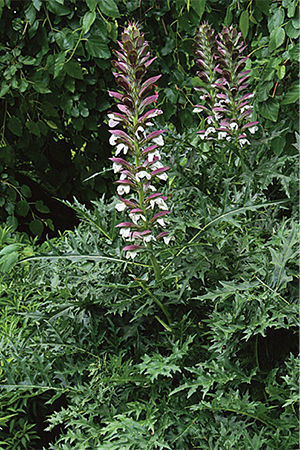
3. A strong, spiky statement
Name: Bear’s breeches (Acanthus spinosus and hybrids)
A popular plant for its bold, almost thistlelike foliage, bear’s breeches is unsurpassed for creating a strong architectural presence. Most plants sold as Acanthus spinosus in garden centers are actually hybrids, but this does not make them any less desirable as all bear’s breeches are worth the investment. The leathery leaves are deeply divided and lightly to heavily spined at their tips; they can reach up to 2 feet long and 18 inches wide. Good drainage is essential; bear’s breeches despises heavy clay soils that stay cold and wet, especially during winter. This plant is the most sun tolerant of all Acanthus and needs at least half a day of sun to perform well, even in the South, where other species tend to melt. The white-and-dusky-purple-hooded flowers appear on 3-foot-tall spires in early to midsummer.
Zones: 5 to 9
Size: Up to 5 feet tall and 3 feet wide
Conditions: Full sun to partial shade; fertile, moist, well-drained soil
4. Jazz up masses of smaller leaves
Name: Cup plant (Silphium perfoliatum)
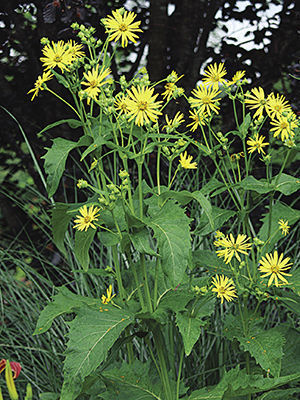
Cup plant is one of three species of Silphium (also known as rosinweed) that are worthwhile additions to the back of the border or for naturalizing in open meadows and prairie plantings. Some might consider it coarse, but cup plant’s bold foliage (and soaring height) is perfect for breaking up the monotony of smaller-leaved perennials. Because it is a prairie native, cup plant is also an ideal complement to ornamental grasses. Its leaves, which might be more than a foot long and nearly as wide, are borne opposite one another and clasp the stem to form a “cup” where rainwater collects, which supports a variety of grassland birds and beneficial insects in its native habitat. Daisylike, bright yellow flowers appear in mid- to late summer, and the seeds, which mature in autumn, are a favorite of finches.
Zones: 5 to 9
Size: Up to 8 feet tall and 3 feet wide
Conditions: Full sun; moist to wet soil; tolerant of clay soil
5. Give this bold ground cover plenty of room
Name: Butterbur (Petasites japonicus and cvs.)
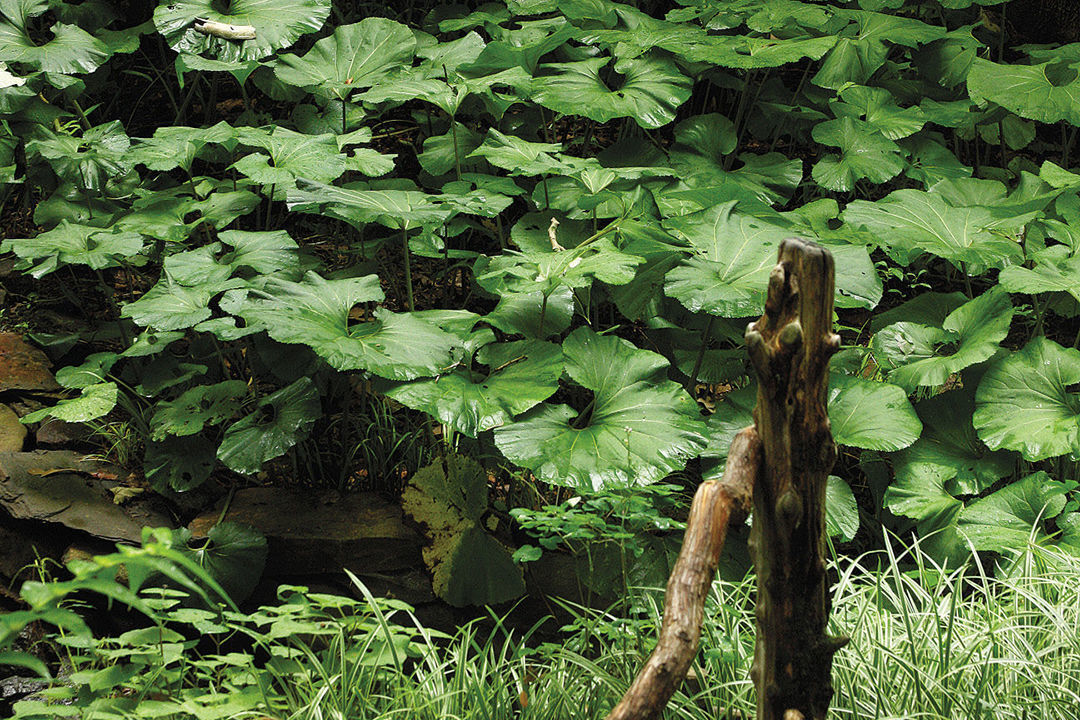
If you have a large area in need of a bold and aggressive ground cover, butterbur might be the perfect choice. There is no denying that when it comes to large-leaved plants that lend an almost primeval feel to the garden, butterbur is it. Its 30-inch-wide leaves, borne on stems almost as tall, are rounded or kidney shaped and are lightly toothed around the edges. Greenish white flowers appear at ground level in late winter or early spring and often go unnoticed. If an even bigger plant is on your wish list, look for giant butterbur (P. japonicus var. giganteus) with leaves that can reach up to 4 feet across on petioles 6 feet tall. Both plants thrive in damp areas or at the water’s edge.
Zones: 5 to 9
Size: Up to 3 feet tall and 5 feet wide
Conditions: Partial to full shade; consistently moist to wet soil
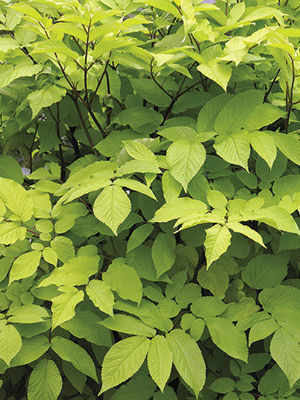
6. A piece of gold for the shade
Name: ‘Sun King’ spikenard (Aralia cordata ‘Sun King’)
I frequently find myself looking for something new and different to get me out of the hosta/hellebore/heuchera rut in my shade garden. Not that there’s anything wrong with any of those plants (I grow them all), but I sometimes just need something unusual to break up the monotony. Enter ‘Sun King’ spikenard. This golden god will brighten and lighten shady corners. And its shrubby habit and compound leaves, which can get up to 3 feet long, are a welcome change in form and texture, contrasting well with broad leaves but bold enough to provide an excellent foil to lacy leaves or fine foliage. ‘Sun King’ will mature at 6 feet tall and wide and shows excellent resistance to deer and other garden pests.
Zones: 4 to 8
Size: Up to 6 feet tall and wide
Conditions: Partial shade; moist, well-drained soil
7. Silver foliage this size can’t be missed
Name: Cardoon (Cynara cardunculus*)
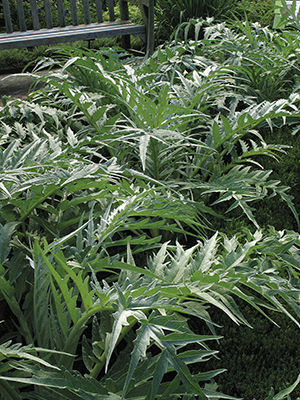
Cardoon is a stunning ornamental plant, closely related to the artichoke, that has come into its own. The basal foliage, which, in mild climates, is present much of the year, is an arching mound of deeply divided and lightly spined, silvery green leaves with a pure white underside. Individual leaves may reach upward of 3 feet long, forming clumps 5 feet across when grown properly. Cardoon needs rich, well-drained soil and occasional deep watering during periods of dry weather. In early to midsummer, stout flower stems bear large spiny buds that open to thistlelike purple blooms. Cardoon will benefit from a hard cutting back immediately after flowering, forcing it to flush new basal foliage, which will remain attractive into late autumn.
Zones: 7 to 9
Size: Up to 6 feet tall and 5 feet wide
Conditions: Full sun; fertile, moist, well-drained soil
*See invasive alert below.
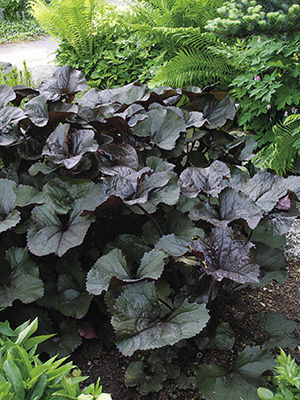
8. Dark foliage that lasts through the season
Name: ‘Britt Marie Crawford’ ligularia (Ligularia dentata ‘Britt Marie Crawford’)
‘Britt Marie Crawford’ is arguably the best of the dark-leaved forms of ligularia, far surpassing ‘Desdemona’ and ‘Othello’ in depth of color and ability to hold that color throughout summer, even in warm climates. As they emerge, the glossy leaves, which might reach 1 foot in diameter, are a deep purplish black. In late summer, bright orange-yellow flowers emerge to dramatic effect on 40-inch-tall black stalks. Ligularias are generally undemanding and easy to grow given a few basic requirements: deep, rich, moist soil (even boggy conditions); occasional feeding to keep plants growing vigorously; and some protection from midday sun in hot climates. Where it can be well watered, ‘Britt Marie Crawford’ makes an outstanding single specimen in a large container.
Zones: 4 to 8
Size: Up to 2 feet tall and 3 feet wide
Conditions: Partial to full shade; humusy, rich, moist to wet soil
9. The best of the big hostas
Name: ‘Sum of All’ hosta (Hosta ‘Sum of All’)
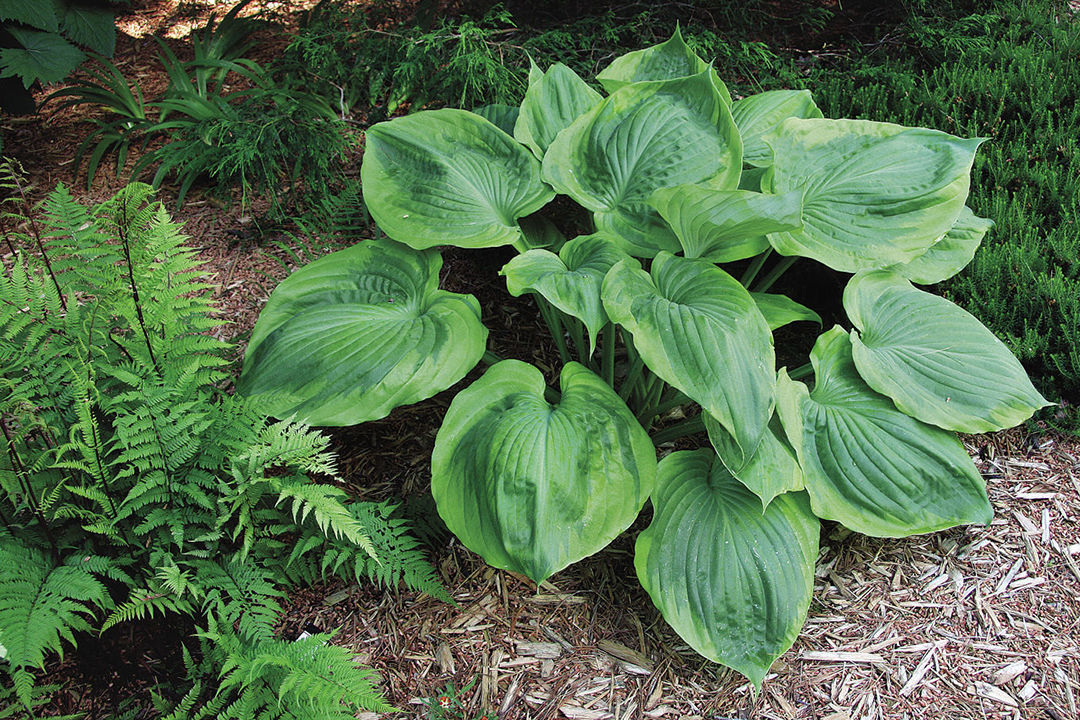
When it comes to a large-leaved perennial for the shade, few plants can outcompete hosta, especially when you consider the broad range of climates and soil types where it successfully grows. At, or certainly near, the top of the giant hosta list is ‘Sum of All’, a gold-margined sport arising from the popular cultivar ‘Sum and Substance’. In addition to the variegated edge, its huge, light green leaves feature prominent rippling. Once it has reached maturity, ‘Sum of All’—like all hostas—should be divided every three to five years to help keep it vigorous. A few hours of morning sun or high, dappled shade will enhance the coloration of the leaves, which, on well-grown plants, might reach up to 18 inches long and 16 inches wide.
Zones: 3 to 9
Size: Up to 3 feet tall and 6 feet wide
Conditions: Partial shade; moist, well-drained soil
10. Your options for dry shade just got more interesting
Name: ‘Spider’s Web’ Japanese aralia (Fatsia japonica ‘Spider’s Web’)
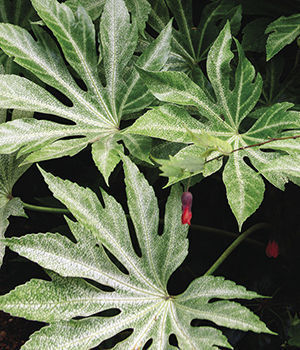
If it’s a tropical or subtropical look you want for your garden, you can hardly go wrong with ‘Spider’s Web’ Japanese aralia. In cool regions, it makes a splendid summertime annual or container plant and can be successfully overwintered as a houseplant or greenhouse plant to use again in the garden the following year. In warmer climates, where winter temperatures are moderate and freezing weather is spare or fleeting, it will thrive in the garden year-round and make impressive clumps of foliage, with leaves reaching 2 feet in diameter on plants up to 5 feet tall. Japanese aralia thrives in rich, well-amended soil in partial to full shade and is a tough plant once established. ‘Spider’s Web’ will more than hold its own in dry shade, with its unique and beautiful white-variegated leaf margins.
Zones: 8 to 11
Size: Up to 5 feet tall and wide
Conditions: Partial to full shade; rich, humusy, moist, well-drained soil
Putting Large-Leaved Plants to Work
No garden is too small for a large-leaved plant. The key is knowing how, where, and when to use it, all of which depends on the impression you want to make.
Punctuate with a single plant
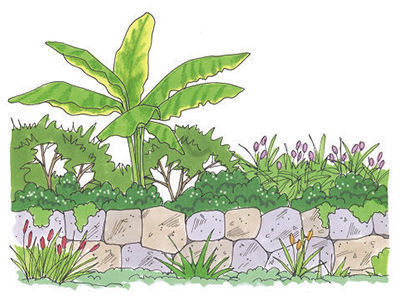
A large-leaved perennial grabs your attention and causes your mind and eye to take a brief pause in a landscape. It breaks up what might otherwise be a monotonous mix of perennials whose leaf shape and form—and often their blooms—are too similar. A large-leaved plant says, “Stop here, and look at me!” and, in doing so, makes you pause and focus not only on it but also on the plants surrounding it. Even in the smallest gardens, a large-leaved perennial might be featured in a container to dazzling effect, lifting it above other plants and helping to create layers while providing that all-important exclamation point in a confined space.
Plant en masse for impact
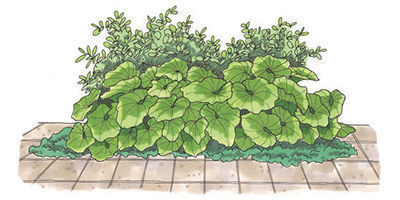
Where space is not constrained, no more dramatic statement can be made in the garden than planting a bold and attention-getting plant en masse. Large masses of a single variety of any kind of plant create an impact, but when the plant also happens to have a particularly powerful presence, the effect is enhanced. Impressive rivers of large hostas rolling through a woodland garden, for example, or the striking contrast created between a mass of spiny bear’s breeches and the solid backdrop of a wall or foundation are scenes that read well from long distances, while up close, the large-leaved plants themselves provide the perfect backdrop for smaller plants among them.
*Invasive alert: Cardoon (Cynara cardunculus)
This plant is considered invasive in CA.
Please visit invasiveplantatlas.org for more information.
Troy B. Marden specializes in garden design, hosts Volunteer Gardener on Nashville Public Television, and is a lecturer and avid garden photographer.
Photos, except where noted: Lynn Felici-Gallant. Illustrations: Martha Garstang Hill
The following mail-order plant sellers offer the widest selection of the plants featured:
- Forestfarm, Williams, Ore.; 541-846-7269; forestfarm.com
- Logee’s, Danielson, Conn.; 888-330-8038; logees.com
- Made in the Shade Gardens, Olathe, Kans.; 913-206-6939; hostaguy.com
- Plant Delights Nursery, Raleigh, N.C.; 919-772-4794; plantdelights.com
- Texas Water Lilies, Waller, Texas; 936-931-9880; texaswaterlilies.com
Fine Gardening Recommended Products
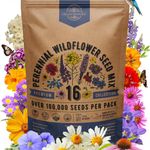
Organo Republic 16 Perennial Wildflower Seeds Mix for Indoor & Outdoors
Fine Gardening receives a commission for items purchased through links on this site, including Amazon Associates and other affiliate advertising programs.

Planting in a Post-Wild World: Designing Plant Communities for Resilient Landscapes
Fine Gardening receives a commission for items purchased through links on this site, including Amazon Associates and other affiliate advertising programs.

Berry & Bird Rabbiting Spade, Trenching Shovel
Fine Gardening receives a commission for items purchased through links on this site, including Amazon Associates and other affiliate advertising programs.


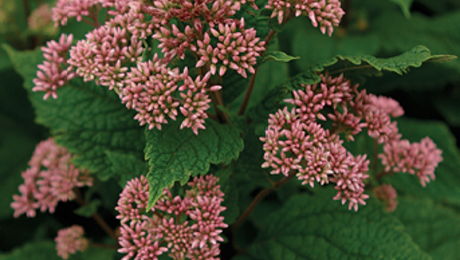















Comments
Log in or create an account to post a comment.
Sign up Log in